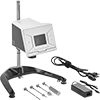Filter by
For Use With
Measures
Maximum Temperature
Thermocouple Sensor Connection
Measurement Unit
Mount Type
Distance Measured
Maximum Continuous Pressure
DFARS Specialty Metals
Weight Capacity
Minimum Temperature
Environment
Sensor Type
Most Likely Products
All Results
Measuring and Inspecting
Lubricating
Fastening and Joining
Fluid Handling
Electrical
Containers, Storage, and Furniture
Facility and Grounds Maintenance
Safety Equipment





























































































































